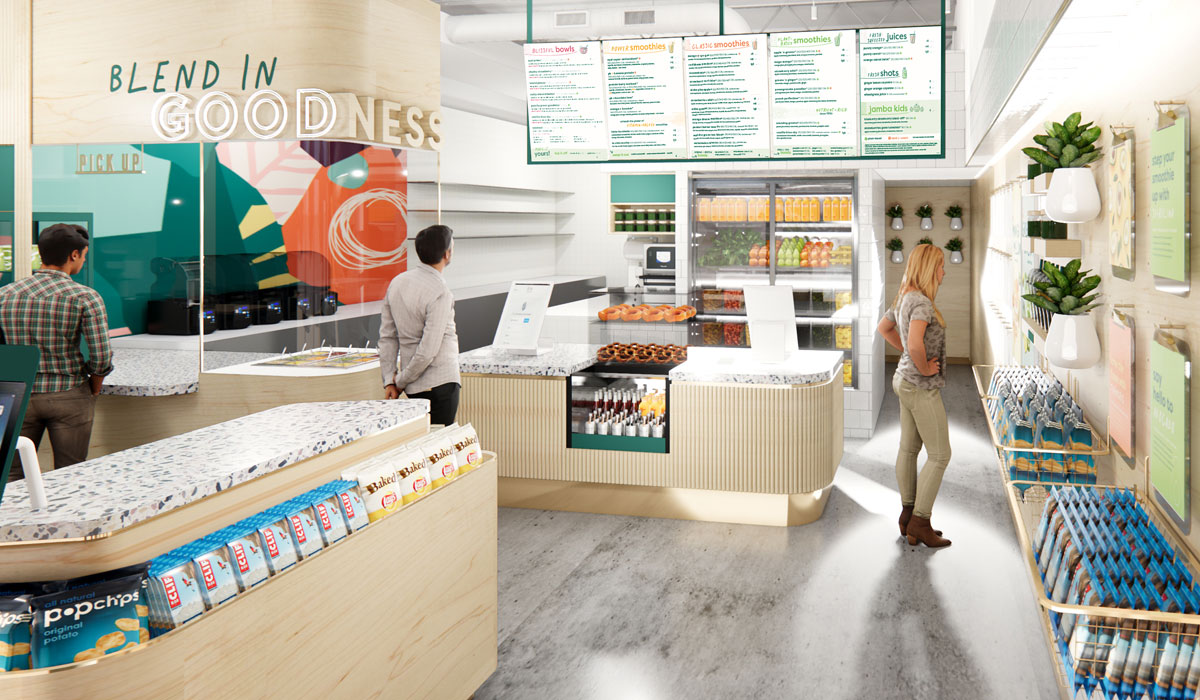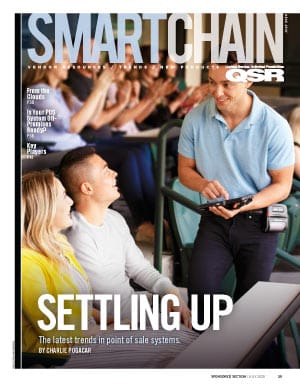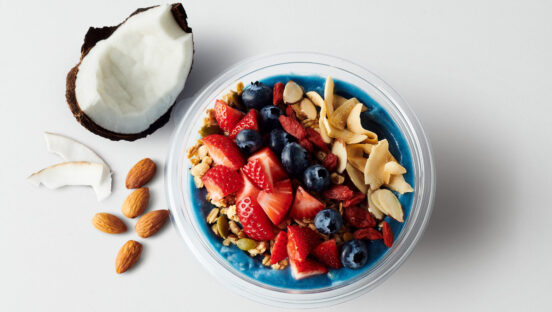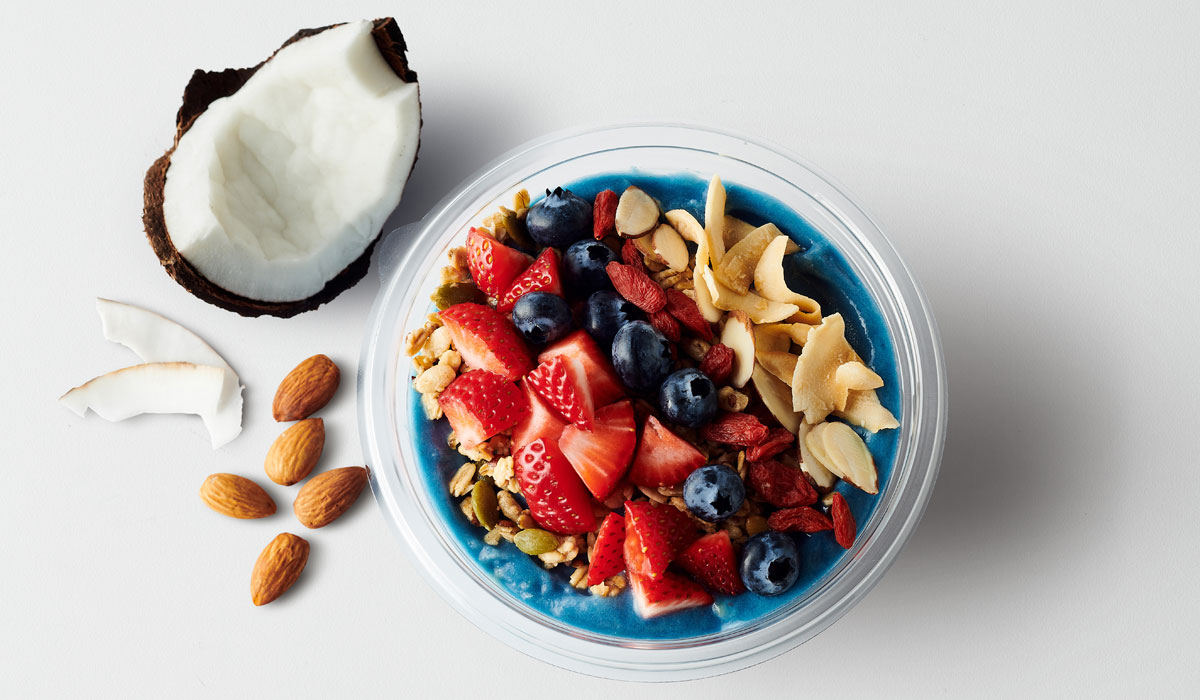It’s been a little over a year since Jamba left the “Juice” behind. Following a $200 million sale to FOCUS Brands, the 30-year-old brand set off on a broad refresh. Like Dunkin’ and its split from “Donuts,” Jamba wanted to present an image that encompassed a wider array of offerings.
In this case, Jamba brought the tagline “Smoothies, Juices and Bowls” into play and placed the focus on a renewed commitment to balanced ingredients, plant-based options, and reduced sugar selections.
The change went live June 6, 2019, and included a host of updates. Perhaps the most visible was a fresh prototype, complete with new logo, and enhanced design elements, like light wood, “freshness cues,” and colorful and expressive elements. The menu transformed to spotlight clear categories and guide consumers into tiers—Power (enhanced smoothies), Classic favorites, and expanded Plant-Based items. More on that effort here.
Yet less outward changes were brewing behind the curtain, too. And while the chain didn’t realize it then, these have turned out to be Jamba’s COVID-19 lifeboats.
Brand president Geoff Henry, named to the role January 2019 from Coca-Cola, where he led lifestyle and beverage business growth in the water, tea and coffee divisions, points to Jamba’s digital accessibility and stack investments. Among the changes, it’s really the one that’s lifted the brand through historic challenges.
In the last 15 months, Jamba rolled a new point-of-sale across its 850 or so stores (785 domestic end of 2019, according to FoodserviceResults), launched a new mobile app and integrated rewards loyalty program, fresh ecommerce-enabled website, and expanded partnerships with third-party aggregators. Today, online transactions are running 300-plus percent higher, year-over-year.
“To be frank, even without the crisis, we had plenty of bumps in the road when we launched our new programs,” Henry says. “It took a few weeks to work through that last summer. But fortunately, we were in a great spot by the middle of last year and we could really accelerate with the crisis in terms of making sure the guest knew about it.”
Jamba has enjoyed the luxury of turning its COVID-19 attention to awareness in recent months instead of infrastructure. It integrated order ahead in Q1—pre-virus—and synched third-party delivery with POS terminals. Jamba also introduced first-party delivery via Olo’s Dispatch in February, which Henry says has “taken off” during the crisis.
The main change was, before February, customers could open the app, order ahead, and pick up. It’s evolved to where guests can access delivery from the app as well.
Jamba offers third-party delivery and direct, via its site and app.
The key is, given the ample challenges COVID-19 presents, having avenues to get food to customers who want is not one of them for Jamba.
“We were fortunate to have a variety of ways to get our product to the guest,” he says.
[image source_ID=”128046″]
Henry says average ticket sizes have risen significantly—like they have for many quick-serves—as solo occasions slide in favor of group orders. It’s been more than double-digits, he says.
Last year’s refresh helped in other ways as well. The store designs unlock updated features, like grab-and-go coolers that support digital convenience and access. Customers pull up and grab and go without needing to enter the store.
Other units have taken a makeshift drive-thru approach, especially in nontraditional venues. Operators purchased signs and cones, tables, tents, and set up an operation out front for consumers to pickup food.
This helped a lot of Jamba’s restaurants remain open from day one forward. Henry says more than 95 percent are up and running today, and the majority avoided temporarily closures throughout.
COVID inspired model innovation. Jamba launched its first food truck in Atlanta—providing franchisees with a lower-cost-to-entry opportunity. Henry says it’s also helped Jamba get the brand to more places and deliver food in new ways, an important lever as lockdown behavior limits travel patterns.
“If you were a franchisee and you were interested in a food truck, I think the best combination would be if you already had a store, the food truck would help you extend the reach in the marketplace and help build the brand and get the product in more places, and perhaps unexpected places,” Henry says.
“Obviously, time will tell what the ultimate impact of COVID-19 will be on behaviors and habits,” he adds of the food truck’s future. “But, certainly, I think the food truck and its capabilities are highly relevant for urban locations. I could also see it in suburban or more coastal locations.”

Consider it an extension of a new-look Jamba. The brand tapped a local Atlanta artist to create a mural and, like all food trucks, it’s serving as a roaming billboard for Jamba.
Looking ahead, Henry says there’s been a steady increased in franchisee interest. He believes COVID-19 and shelter-in-place mandates inspired a lot of people to start thinking about their future from angles they hadn’t before. And the helplessness of the situation, in many ways, shoved entrepreneurial-centric options in the spotlight.
Franchising fits the bill, as the pandemic’s impact on the workplace leads professions to reevaluate what they want to do and why they do it. “The industry is getting more attention for folks who have been looking at it for a while and now see it as potentially the right opportunity to step in or step in and learn before they expand,” he says.
Jamba’s inclusion in FOCUS Brands’ seven-unit portfolio (Moe’s, McAlister’s Deli, Cinnabon, Carvel, and Auntie Anne’s) stirs some unique possibilities. Jamba namely touts co-branding activations with Auntie Anne’s, but there’s also some tri-branding taking form with Cinnabon included.
“One, they’re small footprint,” he says. “Two, they’re designed for on-the-go. So there’s a lot of synergies, at least from an operations and design standpoint, relative to Jamba, which can make for a very efficient build-out, which is great for a guest experience.”
“While we have different product offerings and different frequency of loyal guest visits, it can certainty be the same guest but perhaps at different times,” Henry adds.
In more recent days with dine-in coming back, Jamba witnessed digital transactions hold after March and April spikes. Henry doesn’t believe customers’ sudden affinity for convenience and accessibility are going to fade when COVID-19 cases do. Consumers will continue to turn on the channels they leaned on during the pandemic, especially at brands built around speed and convenience to begin with (like a smoothie-focused chain).
Henry also sees a chance for wellness brands to progress forward with immunity-boosting options and balance their menus with made-to-order products that meet evolving consumer demand.
In Jamba’s small footprint, customers see the entire restaurant once they walk through the door. There’s zero mystery, which is becoming essential given the invisible enemy in the room.
“People are going to naturally expect more of that going forward where they can have that just the way they want it,” he says. “I think we’re well positioned in that space as well. Combined as well with the transparency of what we’re offering, obviously with this health crisis with COVID, people want to know what’s in their food.”






